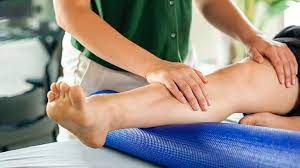If you’re like most people, you probably don’t know too much about physical therapy’s meaning. You might think that it’s only for people who have been in car accidents or who are recovering from surgery. While physical therapy meaning can be helpful for those people, it can also be beneficial for a wide range of other issues. In this blog post, we will discuss what physical therapy is and how it can help improve your health and well-being.
Contents
What Is The Meaning Of Physical therapy?

Meaning of physical therapy is the branch of medicine that deals with the treatment of physical disabilities or injuries. It is also known as physiotherapy. The main aim of physical therapy is to restore the normal function of the body parts and to relieve pain. physical therapy can be meant to treat a wide variety of conditions, such as arthritis, spinal cord injuries, stroke, and cerebral palsy.
What Are The Categories Of Physical Therapy?

Physical therapy can be divided into various categories. These are as follows:
Orthopedic physical therapy
This type of PT is focused on helping patients recover from injuries or surgeries involving the musculoskeletal system. For instance, an orthopedic PT might work with a patient who recently had a hip replacement.
Cardiovascular and pulmonary physical therapy
This type of PT is focused on helping patients with conditions affecting the heart and lungs, such as COPD or heart failure. For example, a physical therapist might help a patient with COPD learn how to better manage their breathing or work with a heart failure patient on an exercise plan that won’t strain their heart.
Neurological physical therapy
This type of PT is focused on helping patients recover from injuries or illnesses affecting the nervous system. For example, a person who has suffered a stroke may receive neurological PT to help them regain movement and function.
Geriatric physical therapy
This type of PT is focused on helping older adults prevent falls and live independently for as long as possible. PT can help seniors improve their balance, flexibility, and strength. For example, a geriatric PT may help an older adult who is at risk for falls to create a safe environment in their home.
Pediatric physical therapy
This type of PT is focused on helping children recover from injuries or illnesses. For instance, if a child has cerebral palsy, physical therapists can help them regain movement and improve their quality of life.
Orthopedic physical therapy
This type of PT helps patients recover from injuries or surgeries to the bones, muscles, and joints. For example, someone who has had a hip replacement may see an orthopedic PT to help them regain their range of motion and reduce pain.
Women’s health physical therapy
This type of PT is focused on helping women recover from injuries or illnesses affecting the reproductive system. For instance, a women’s health PT may help someone recovering from a C-section or pelvic surgery.
Prenatal and postnatal physical therapy
Prenatal PT helps expectant mothers prepare for childbirth, both mentally and physically. Postnatal PT can then aid in the recovery process after delivery. This type of PT often includes exercises to help new mothers heal from the strain of pregnancy and childbirth, as well as advice on how to care for a newborn.
There are many different categories of physical therapy, each with a different focus. The type of therapy that is right for you will depend on your specific condition or injury. Your doctor or physical therapist will be able to help you choose the right type of therapy for your needs.
What Conditions Does It Treat?
The Common conditions through which physical therapy works are:
- Cardiopulmonary conditions, such as chronic obstructive pulmonary disease, cystic fibrosis, and post-myocardial infarction heart failure
- Neurological conditions, such as Alzheimer’s disease, cerebral palsy, multiple sclerosis, and Parkinson’s disease.
- Spinal cord injuries orthopedic conditions, such as arthritis, amputations, back pain, bunions, carpal tunnel syndrome, and tendon geriatric conditions, such as falls, incontinence, and osteoporosis women’s health and pelvic floor disorders cancer conditions, such as lymphoma and leukemia.
- Other conditions it treats are chronic pain, headaches, obesity, pregnancy and postpartum conditions, and sports injuries.
As age, you may start to experience more aches and pains. You may also begin to lose mobility and function. Physical therapy can help seniors regain their quality of life. Physical therapy is a type of rehabilitation that uses exercises and other techniques to improve movement and relieve pain.
What Does It Involve?
The treatments that are provided by physical therapists can be divided into two categories: passive and active.
Passive treatments involve the use of modalities, such as heat, cold, or electrical stimulation, to relieve pain and conditions post-surgical rehabilitation, or to aid in the healing process.
Active treatments, on the other hand, require patients to put in some work. These treatments may involve exercises to improve strength, flexibility, and range of motion; manual therapy techniques to increase mobility; or education on how to properly manage pain.
Most physical therapy programs will likely include a combination of both passive and active treatments
How Does Physical Therapy Works?
Physical therapy is a type of treatment that helps people recover from injuries and improve their mobility. It will include:
- Exercises to improve range of motion and strength: Physical therapists will teach patients exercises that help them regain movement and strength in the affected area.
- Manual therapy: This involves using the hands to massage the muscles and joints to reduce pain and increase the range of motion. This type of physical therapy involves using the hands to manipulate the soft tissues and joints. For example, your therapist may use massage, stretching, and mobilization techniques to help reduce pain and improve the range of motion.
- Therapeutic modalities: This includes using heat, cold, or electrical stimulation to help relieve pain.
- Education and advice: Physical therapists will also teach patients about their condition and how to prevent further injuries. They may also give advice on lifestyle changes, such as diet and exercise. Physical therapy can be used to treat a wide variety of conditions.
- Ultrasonic Therapy: This therapy uses sound waves to create vibrations in the tissue. The vibrations help to reduce pain and inflammation. Ultrasonic therapy is often used to treat conditions such as arthritis, tendonitis, and bursitis.
- Myofascial release: It is a type of physical therapy that focuses on releasing restrictions in the fascia, or connective tissue. The fascia is a network of tissues that surround and support the muscles, bones, and organs. Myofascial release can help to relieve pain, improve the range of motion, and reduce inflammation.
Your physical therapist will develop a treatment plan specifically for you, based on your individual needs. The length of treatment will depend on the severity of your condition. In most cases, physical therapy will be a long-term treatment.
What Are the Benefits of Physical Therapy?
There are many benefits of physical therapy, such as:
Improve mobility: Physical therapy can help improve your range of motion and ability to move your joints and muscles. If you have trouble moving around, physical therapy can help. It can increase your range of motion and decrease stiffness. A therapist can also teach you how to use assistive devices, such as canes or walkers if needed.
Relieve pain: Physical therapy can help to relieve pain caused by conditions such as arthritis, back pain, and carpal tunnel syndrome. Physical therapy can help increase your range of motion and improve your ability to move around. Whether you’re dealing with chronic pain or recovering from an injury, physical therapy can help.
Prevent or recover from injuries: Physical therapy can help you prevent injuries by improving your flexibility, strength, and balance. It can also help you recover from an injury by reducing pain and swelling, improving your range of motion, and helping you regain strength.
Manage chronic conditions: Physical therapy can help you manage chronic conditions such as arthritis, back pain, diabetes, heart disease, and more. By improving your mobility and strength, physical therapy can help you stay active and independent.
Improve the quality of life: Physical therapy can help improve your quality of life by reducing pain, improving your ability to do the things you love, and helping you live a healthier life.
Prevent falls: Falls are one of the leading causes of injuries in older adults. Physical therapists can help reduce the risk of falls by developing a personalized balance and strength program. They can also teach patients how to safely get up from a fall and how to prevent future falls.
Improve circulation: When your circulation is poor, it can cause a host of problems, including fatigue, cramps, and swelling. Physical therapy can help improve your circulation by massaging the affected areas and using electrical stimulation.
Decrease inflammation: Ice, heat, electrical stimulation and massage can all help to decrease inflammation in the body. For example, if you have suffered a recent injury, your physical therapist will likely recommend using ice to help reduce swelling.
Improve range of motion: Physical therapy can help to improve a patient’s range of motion by stretching muscles and joints. For example, if you have stiffness in your shoulder, a physical therapist can help to loosen the area and improve your range of motion.
Improve balance: Balance exercises are often part of physical therapy. These exercises can help to improve your balance and coordination, which can reduce your risk of falls.
Improve flexibility: Stretching exercises can help to improve your flexibility and range of motion. This is important for overall joint health and can also help to reduce your risk of injury. Physical therapists will often prescribe exercises to help patients increase their strength. This is especially important after an injury or surgery, when muscles may be weak.
Help you return to normal activities: After an injury or surgery, it is important to get back to your normal activities as soon as possible. Physical therapy can help you to regain your strength and range of motion so that you can return to your normal activities safely.
Conclusion
It may be concluded that physical therapy meaning is a multi-faceted answer. Depending on who you ask, you may receive a very different answer. However, the common thread between all definitions seems to be the idea of using physical movement to improve someone’s overall health and well-being.
Whether you are looking to relieve pain, improve your mobility, or simply want to live a healthier lifestyle, physical therapy may be a good option for you. Be sure to consult with your doctor or healthcare provider to see if physical therapy is right for you.
Physical Therapy help patients recover from pain. If you’re experiencing Back pain, Shoulder pain, Knee pain, Neck pain, Elbow pain, Hip pain, or Arthritis pain, a physical therapist at MantraCare can help: Book a physiotherapy session.


